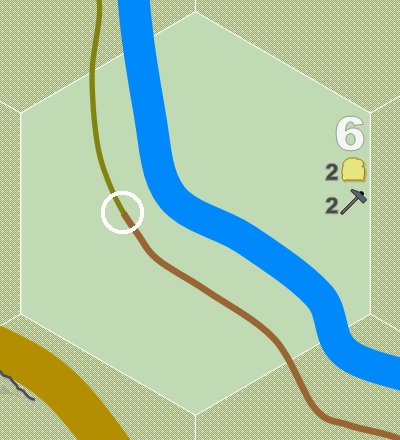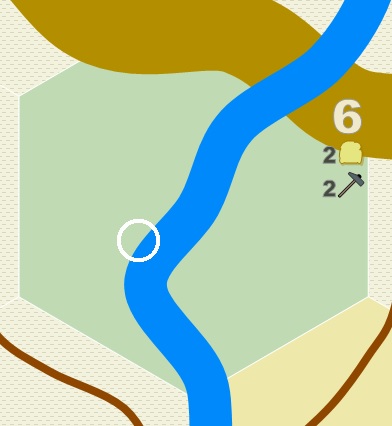Bailey Hamlet
Bailey hamlets are clusters of tightly-knit dwellings and buildings, enclosed within a defensive outerwork known as a bailey, which provides protection to the hamlet's central inner yard. The arrangement typically places the homes and structures of higher-status or more essential residents within the fortified perimeter, while lesser dwellings and service-related outbuildings are often situated beyond the palisade and defensive ditch.
This external area may include hovels, sheds, animal pens or other provisional structures used by labourers and seasonal inhabitants. Though offering minimal defence, these outlying constructions reflect the hamlet's need to accommodate a wider population and support its basic economy, even under limited protection. The bailey itself is usually defined by a wooden or stone palisade, with a shallow moat or ditch surrounding the enclosure, and a single gatehouse or watchpoint regulating access to the yard within.
Such hamlets are always supported by a significant river, with individual farms and communal holdings besides. While they share many characteristics of communal hamlets, a sizable number of persons acting as artisans and skilled labourers accounts for a class of persons that are distinctly non-agrarian, and therefore apart from the communal ideal. Tradition and religion are highly respected and observed, but nonetheless the community's focus is recognisably divided between the stalwart farmer and the business of collecting produce for markets elsewhere. The power of those who go afield each day is diminished by the owner-operators whose presence within the hamlet's walls exercises a greater influence.
The more frequent presence of outsiders who visit, bringing demands and news of the outside in their wake, likewise produces an outward-looking dynamic, very different from that of a communal hamlet. These arrivals introduce a shift in mood and expectation, as the concerns of the wider world find greater foothold within the bailey walls. The rhythms of local life begin to reflect not just the seasons and the fields, but also the timetables of markets, merchants and obligations beyond the river's edge.
Composition
| Form | Facility |
|---|---|
| dwellings | half-timbered house, hovel |
| bulk goods | granary |
| harvesting | communal holding, water well |
| transport | boat dock, carter post, ox tether, stable |
| upkeep | gong pit |
| vendors | bakery |
| workings | fulling mill, gristmill, saw pit, shearing station, winepress |
Determination of a bailey hamlet's population is handled through a population generator, available at this link, under the tab titled "By. Hamlet." The generator includes notes outlining the conditions required for each facility to be present. If no condition is specified, the facility is assumed to be present by default, though it can be removed manually. Entering "no" in the "conditions exist" column sets the resident count to zero. "Nearby farmland" refers specifically to land of those farmers located within the hex but not directly associated with the hamlet or its communal holding.
Because the consistent presence of a significant river enables the reliable operation of water-driven mechanisms, windmills are seldom constructed in these hexes, their utility largely replaced by more efficient and accessible watermills. This reliance on rivers means that certain workings must be positioned beyond the bailey's protective boundary, particularly where the watercourse cannot be easily encompassed by the existing wall. In some cases, where a narrow stream passes close by, the bailey may be extended to enclose a portion of the flow, allowing a mill to be secured within the compound.
Facilities such as saw pits must necessarily be placed near the treeline, which typically lies outside the bailey, and are therefore left exposed. The same is true for the gong pit, boat dock and communal holding, which all require more open or accessible ground than the inner yard can provide. About half the number of hovels occupied by farming families will likewise be found outside the bailey, forming a loosely scattered fringe of lower-status dwellings beyond the wall.
Half-timbered houses within the bailey are usually limited to a single storey in height, built low and broad for ease of construction and maintenance. A water well is typically dug for every thirty-five residents, each located inside the bailey to ensure access and protection; in drier regions where groundwater is less available, a cistern may serve in place of the well, drawing on collected rainfall to meet the settlement's needs.
Leadership
As with communal hamlets, decisions are made by a council of elders. While the elders continue to serve as mentors, guiding daily life and reinforcing tradition, their role within a bailey hamlet is shaped increasingly by external concerns. The responsibility of managing the collection and movement of produce and resources to outside markets draws the council into broader relationships, where recognition, reputation and the possibility of growth hold tangible value. As such, selection to the council depends not only on age and familiarity with local custom, but also on a candidate's organisational skill and practical understanding of trade, negotiation and external affairs. It is not uncommon for a long-time resident, though well-regarded, to be passed over if lacking in presence, clarity or the ability to command attention when needed.
The tension between the community's two primary factions — those who farm and those who live within the bailey as owner-operators — can be difficult to balance. While a capable council may preserve harmony, resentment is easily sown if the perception arises that wealth or opportunity is unequally distributed. Farmers who spend their days labouring in the fields may feel underrepresented or undervalued if the benefits of trade appear to gather chiefly around those who remain behind the palisade. To prevent such imbalance, a bailey hamlet's council typically includes seven or more elders, with an equal number drawn from each factino, with a lead elder expected to uphold the interests of both sides equally, functioning as an anchor during disputes and a point of unity in times of need. While internal disagreements may strain relationships, the presence of any threat from beyond the hamlet's bounds serves as an immediate rallying point, setting aside differences in favour of shared survival.
Economy
Socage is paid jointly by the communal farmers, whose obligations are typically underwritten each year by the owner of the granary. This arrangement allows the farming population to maintain basic sustenance during lean years, with any resulting debt owed to the granary itself rather than to the realm. Such debts are overseen by the council of elders, entered into the private records of the community and managed internally without interference from outside.
The various workings, owners and vendors within the bailey hamlet pay excise taxes only when goods are transported and sold beyond the bounds of the hex. These individuals are otherwise exempt from direct taxation, as their operations remain too modest or remote to draw the attention of the realm's assessors. This exemption creates a favourable environment for local trade and enterprise, offering the hamlet the potential for organic growth and gradual economic expansion.
Land within the bailey hamlet is not held under individual ownership. Instead, tradition distinguishes between ground treated as "communal" and parcels which, by custom, are held in name by the owner-operators. The realm does not challenge this internal arrangement, and as long as the hamlet remains modest in scope, the issue of legal ownership is not forced. However, should the settlement grow to the point of gaining a recognised "coin," it becomes necessary to pursue formal recognition through a charter, at which point these informal understandings must be translated into terms acceptable under law.
Within the community, a barter economy continues to function as the primary means of exchange. Agreements are in place that entitle each resident to receive their "lot" — a proscribed daily portion of bread or specific service — from the local bakery or gristmill, granted in return for regular contributions made to the hamlet. These contributions may take the form of annual food deliveries to the granary, or labour and duties performed in support of the broader needs of the community.
Requests that fall outside of routine expectations, such as the use of transport to venture from the boat dock, are not covered by standard arrangements and must be negotiated directly between individuals. Farmers from the surrounding area who are not part of the bailey hamlet itself are not party to these internal agreements and must bargain for all services or goods on a case-by-case basis. The hamlet does not possess sufficient coinage to honour formal notes payable, and such instruments must be negotiated and settled beyond the local economy.
Hex Examples
As bailey hamlets always exist on or near a significantly sized river, it's rare to find a surrounding type-6 hex that does not contain both a road and a river. In most cases, the hamlet will favour the road for its reliability and ease of overland transport; however, where no road exists, the river is sufficient to serve as the primary means of connection to the outside world. The wide caramel line depicted on the right-hand hex represents a national border.
Generator
A generator for determining a bailey hamlet's population and surrounding hex can be found here: generator.
See also,
Bread (symbol)
Coin (symbol)
Hammer (symbol)
The Adventure


